On-Site vs Digital Corporate Fitness Programs: Get the Best of Both Worlds for Your Workforce With a Unified Program
Last Updated Sep 25, 2025

You’ve got a team scattered across time zones. Some hit the gym before dawn. Others squeeze in a stretch session between meetings. A few haven’t exercised since the office yoga class in 2019. Sound familiar?
Welcome to the modern workplace—where flexibility reigns and one-size-fits-all wellness plans fall flat. As an HR leader, you’re juggling remote work, tight budgets, and employees who want more from their benefits. And when it comes to fitness? You need something that works for everyone.
That’s where understanding the three types of corporate fitness programs can make or break your strategy. Whether you’re building community with on-site classes, empowering flexibility through digital tools, or aiming for a unified experience that does both, the right structure can boost engagement, reduce costs, and support every employee—wherever they are.
Unlock the secrets to choosing the right fitness model—and see how a unified approach can deliver measurable ROI, stronger retention, and healthier outcomes.
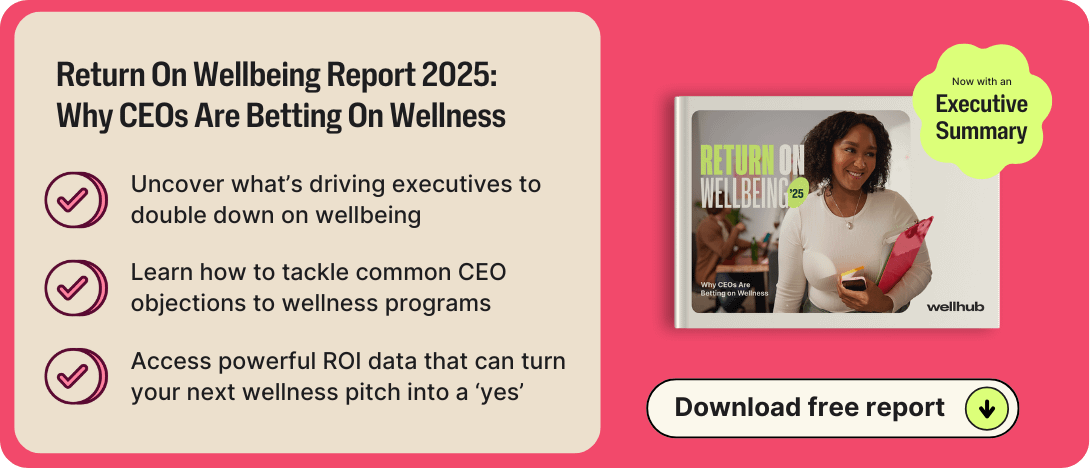
What You’ll Learn:
- The Three Main Types of Corporate Fitness Programs: A clear breakdown of on-site, digital, and unified models—including how each works, who they best serve, and their pros and cons.
- Why Unified Programs Deliver the Highest ROI: How blending in-person and digital options maximizes accessibility, engagement, and cost-effectiveness across diverse workforces.
- Real-World ROI & Impact Data: Concrete results from Wellhub clients, including $540M in total value, reduced healthcare costs, improved retention, and nearly $1,000 in annual employee savings.
- How to Successfully Implement a Unified Program: Five practical steps HR can take—choosing a centralized platform, prioritizing flexibility, communicating often, leveraging data, and aligning with broader benefits strategy.
- Legal & Compliance Considerations: Key safeguards around liability waivers, ADA accessibility requirements, and HIPAA-compliant data practices to ensure programs are safe, inclusive, and legally sound.
The 3 Different Types of Corporate Fitness Programs
Corporate fitness programs typically fall into three main structures: in-person, digital, and unified.
In-person fitnessprograms can be on- or off-site. Onsite bring wellness directly into the workplace, offering employees access to fitness classes, equipment, or even full gyms without leaving the office. Off-site in-person programs, on the other hand, give employees access to local gyms and studios through partnerships or subsidies, providing more variety and flexibility—especially for those who prefer to work out on their own schedule.
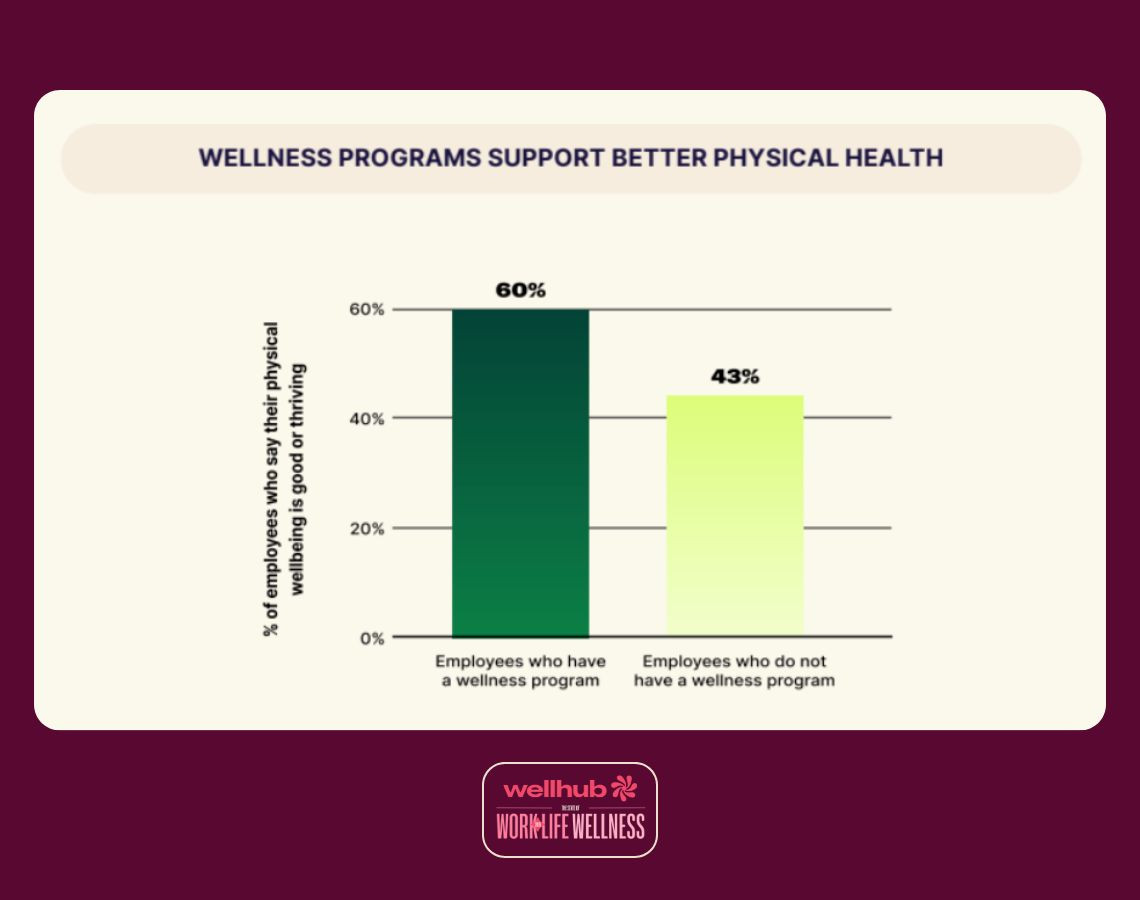
Digital fitness programs offer employees on-demand access to workouts, wellness apps, live-streamed classes, and even virtual personal training. These programs are ideal for remote workers, frequent travelers, or employees with unpredictable schedules. They’re also a great fit for companies looking to expand access without investing in physical infrastructure. With just a phone or laptop, employees can tap into a wellness experience that’s personalized, private, and available anytime, anywhere.
But the most effective approach for today’s flexible workforce is the unified model. Unified fitness programs combine both in-person and digital offerings, providing the structure and community of on-site offerings with the flexibility of digital and off-site options. This “best of both worlds” approach ensures all employees—regardless of where or when they work—can access wellness in a way that works for them. And when managed through a centralized platform like Wellhub, unified programs are easy to manage and scale.
On Site vs. Digital vs. Unified Fitness Programs
On-Site Fitness Programs
On-site fitness programs bring wellness directly into the workplace. They’re best for companies with mostly in-person teams, and for leaders who want to use fitness as a culture-building tool. These programs can include a range of facilities and activities. Common ones include:
- On-site fitness facilities and gyms: Depending on budget and space, these could range from full gyms to smaller workout spaces available during or after work hours.
- In-person group classes: Examples include yoga, strength training, or spin sessions led by certified instructors.
- Health and wellness workshops: Seminars on topics such as nutrition, posture, and stress management can be held right at the office.
- Active team-building activities: Company sports leagues, gym challenges, or marathons can encourage people to get moving together.
Benefits
The strengths of on-site programs include:
- Stronger community and team building: Shared workouts strengthen bonds across departments and within teams.
- Convenience for in-office staff: Employees can exercise without buying external memberships or commuting.
- Personalized coaching: In-person trainers demonstrate moves, correct form, and give instant feedback.
- Higher engagement for new exercisers: Real-time guidance builds confidence and minimizes injury risk.
- Promotes work-life wellness: A dedicated space shows employees that health is part of the company culture, not something they have to squeeze in after hours.
Challenges
On-site programs come with some trade-offs, though. Remember to consider the following when comparing and contrasting on-site with digital and unified fitness and wellness programs:
- High cost: Building or retrofitting a gym requires staff investment and equipment, which can easily inflate wellness program costs.
- Excludes remote and hybrid workers: Offsite workers can’t benefit from facilities they rarely or don’t visit.
- Privacy concerns: Some employees are uncomfortable exercising in front of colleagues.
- Logistics: Scheduling, maintenance, and program oversight require ongoing effort from everyone. This can be difficult to sustain, especially if you have a small team that's already strained.
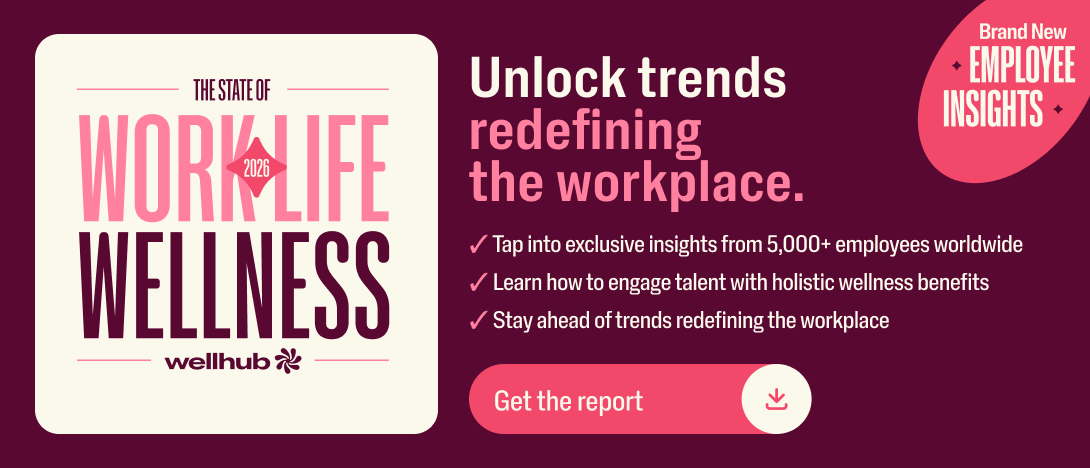
Digital Fitness Programs
Digital fitness platforms allow your employees to exercise anywhere and anytime. With just a phone or laptop, they can stream a workout, follow a wellness plan, or join a live class. Consider this option if you have remote or hybrid staff or need something more budget-friendly.
Digital fitness programs often include:
- On-demand workouts: Video libraries can cover a wide range of activities, including yoga, HIIT, breathing exercises, and meditation.
- Virtual personal training: One-on-one coaching can be delivered through video conferencing.
- Live-stream sessions: Employees can join live classes from home or on the road.
- Wellness apps: These mobile apps track habits, progress, and goals. These often connect directly with wearables like Fitbit or Apple Watch, or sync with apps like MyFitnessPal, making it easy for employees to track activity and progress seamlessly.
- Gamified fitness challenges: Badges, points, and leaderboards can turn fitness into a game, making people more likely to stick to their routine.
Benefits
Here’s what to expect from an online workout class:
- Accessibility and flexibility: Employees can log in from anywhere and choose sessions that fit their schedules.
- Lower costs: Digital fitness program subscriptions or licenses often cost less than in-person classes and maintaining an in-office gym.
- Personalized user experience: Many platforms use AI to recommend workouts or plans based on individual goals and data. For example, it can build a program tailored specifically for a 5-foot-8-inch woman who weighs 150 pounds and wants to become more flexible.
- Variety: Programs include nutrition support, sleep tracking, and emotional wellbeing tools.
- Gamification: Points, challenges, and achievements keep employees motivated and connected, even when working apart.
Challenges
Like any approach, digital corporate fitness programs have some drawbacks. These include:
- Less in-person connection: While digital social features like chat and challenges help, they can’t fully replace the camaraderie of in-person workouts.
- Screen fatigue: After a day of screen-heavy work, some employees may not want additional screen time.
- Less accountability: Without face-to-face guidance, some employees find it harder to stay consistent, especially if they’re new to fitness.
- Best for self-starters: On-demand digital classes often attract employees who are already motivated. Newcomers to fitness may need additional support.
Unified Fitness Programs (In-Person and Digital)
Unified fitness programs combine the benefits of both on-site and digital offerings into a single, cohesive experience.
These are ideal for HR leaders who want to offer flexible wellness options without sacrificing engagement or ease of management. They make it easy to support holistic wellness, which is critical to running an effective program: Research thehighest returns on investment come from holistic wellbeing programs. And by offering multiple entry points, they allow employees across your diverse workforce to naturally integrate whole person wellness into their life, no matter what their day looks like.
Unified fitness programs often include:
- On-site options: In-office classes, open gym access, or scheduled fitness events for employees who come into a physical location.
- Off-site partnerships: Access to nearby gyms, studios, or wellness centers through corporate memberships or class passes.
- Digital access: On-demand video workouts, meditation and mindfulness apps, and virtual personal training sessions.
- Live-streamed content: Real-time classes employees can join from home, a hotel room, or anywhere they have Wi-Fi.
- Mobile wellness tools: Apps and wearables that allow employees to track progress, join fitness challenges, or receive personalized workout recommendations. For instance, an employee might check into a local gym session through Wellhub, sync their workout data via Strava, and track recovery through their wearable.
Benefits
Unified programs bring together the strengths of both digital and in-person approaches, such as:
- Flexibility for every schedule: Whether employees work from home, come in daily, or travel for business, they can access wellness support that works for their lifestyle.
- Wider accessibility: Employees in different locations or time zones can still participate fully.
- Increased engagement: Multiple options mean people are more likely to find something they’ll stick with, no matter their fitness level or personal preferences.
- Community and connection: On-site classes build camaraderie, while digital tools keep teams connected through virtual challenges and shared goals.
- Easy administration: With a platform like Wellhub, everything—class scheduling, data tracking, and vendor management—lives in one system.
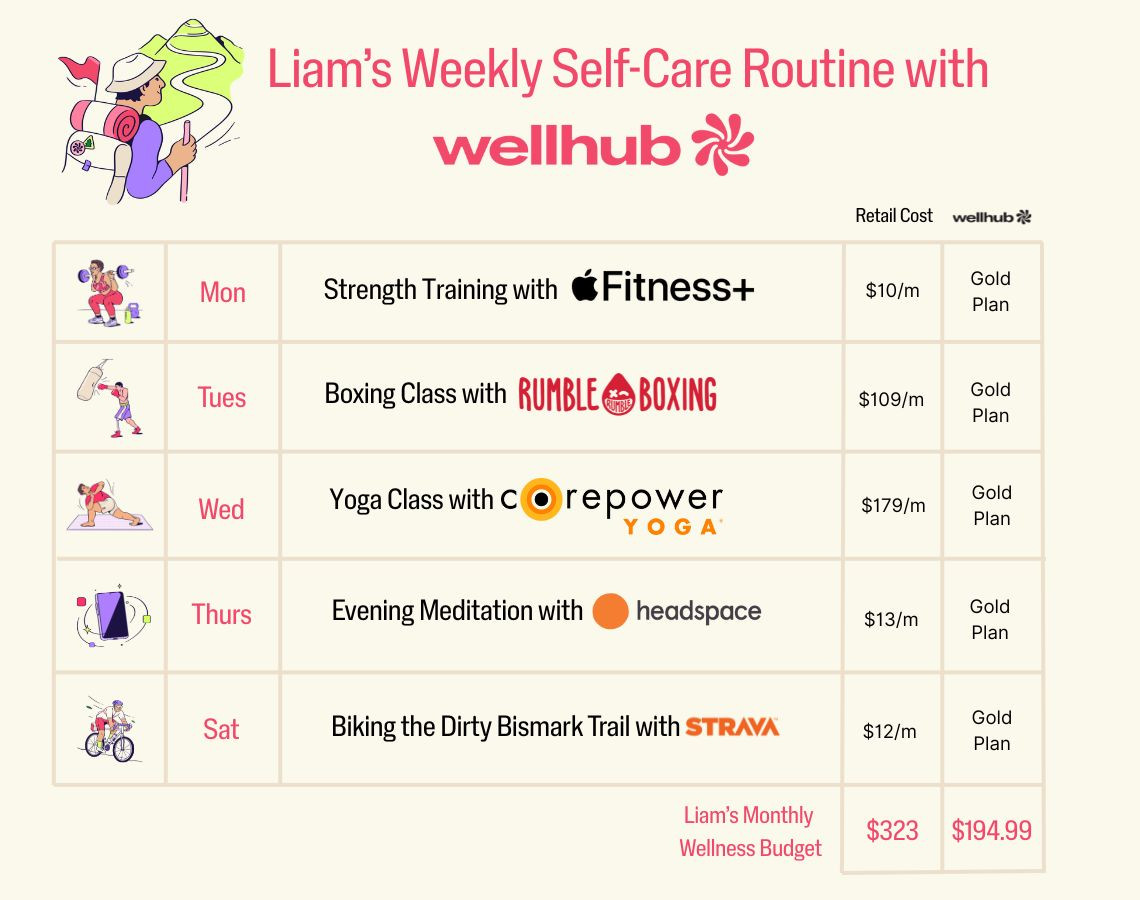
Challenges
Unified programs are highly effective, but they do require thoughtful planning. Key considerations include:
- Program coordination: Offering multiple access points can be logistically complex without a central management platform.
- Varied preferences: With more options comes the need for more personalization to meet the diverse needs of your team.
- Tech readiness: A seamless digital experience depends on strong user experience and reliable platforms.
Wellhub is built to eliminate the complexity of managing a unified fitness program. Instead of juggling multiple vendors, platforms, and communication channels, HR teams get one centralized system that handles it all. The platform seamlessly integrates on-site offerings, off-site gym access, and digital wellness tools—making it easy to deliver a consistent experience to every employee, regardless of location or schedule. And with data-rich reporting dashboards, you’ll always have a clear view of program performance and ROI—all in one place.
Key Takeaways:
- Unified fitness programs deliver the highest ROI by combining the strengths of digital and in-person options.
- They aremore cost-effective than standalone in-person programs due to lower infrastructure and maintenance needs.
- They are the easiest for employees to participate in—remote, hybrid, and in-office employees alike—driving up engagement rates.
- With Wellhub, these programs are fully integrated and easy to manage across every modality.
| On-Site | Digital | Unified | |
|---|---|---|---|
| Location | Workplace gyms, classes, workshops | Apps, streaming, virtual PT | Combo: on-site, off-site, digital |
| Best For | In-office teams, culture building | Remote/hybrid staff, budget-friendly | Mixed workforces, maximum reach |
| Benefits | Team bonding, convenience, live coaching | Flexible, low cost, personalized, variety | Flexible for all, wider access, strong engagement, easy admin |
| Challenges | High cost, excludes remote, logistics | Less connection, screen fatigue, low accountability | Complex to coordinate if platform support is lacking, tech-dependent |
| Cost | High | Low–moderate | Low-moderate |
| ROI | Moderate (strong in-office, limited reach) | Moderate (affordable, variable engagement) | High (broadest access, best engagement) |
Key Comparison Takeaways:
- Unified fitness programs deliver the highest ROI by combining the strengths of digital and in-person options.
- They are morecost-effective than standalone in-person programs due to lower infrastructure and maintenance needs.
- They offer the highest engagement rates because they’re accessible to everyone—remote, hybrid, and in-office employees alike.
- With Wellhub, these programs arefully integrated and easy to manage across every modality.
Real World Examples: The Wellhub Effect
And with Wellhub, you don’t just get a unified experience for your people. You get a unified system for your team to manage it all.
Across industries and company sizes, Wellhub clients see measurable results—better health outcomes, stronger retention, and major cost savings.
Here’s how that unified impact adds up.
Wellness That Pays for Itself
Wellhub clients see, on average, more than 3x ROI from their investment in unified wellness. And that’s not a theoretical model—it’s real-world data pulled from our global client base.
In 2023, Wellhub delivered over $540 million in total value to our clients and their employees:
- $200 million in reduced healthcare costs
- $50 million in savings from improved retention and reduced recruiting spend
- $290 million in fitness and wellness discounts used by employees
Whether employees joined on-site classes, used local gyms, or streamed workouts from home, the result was the same: they got what they needed—and the company got real returns.
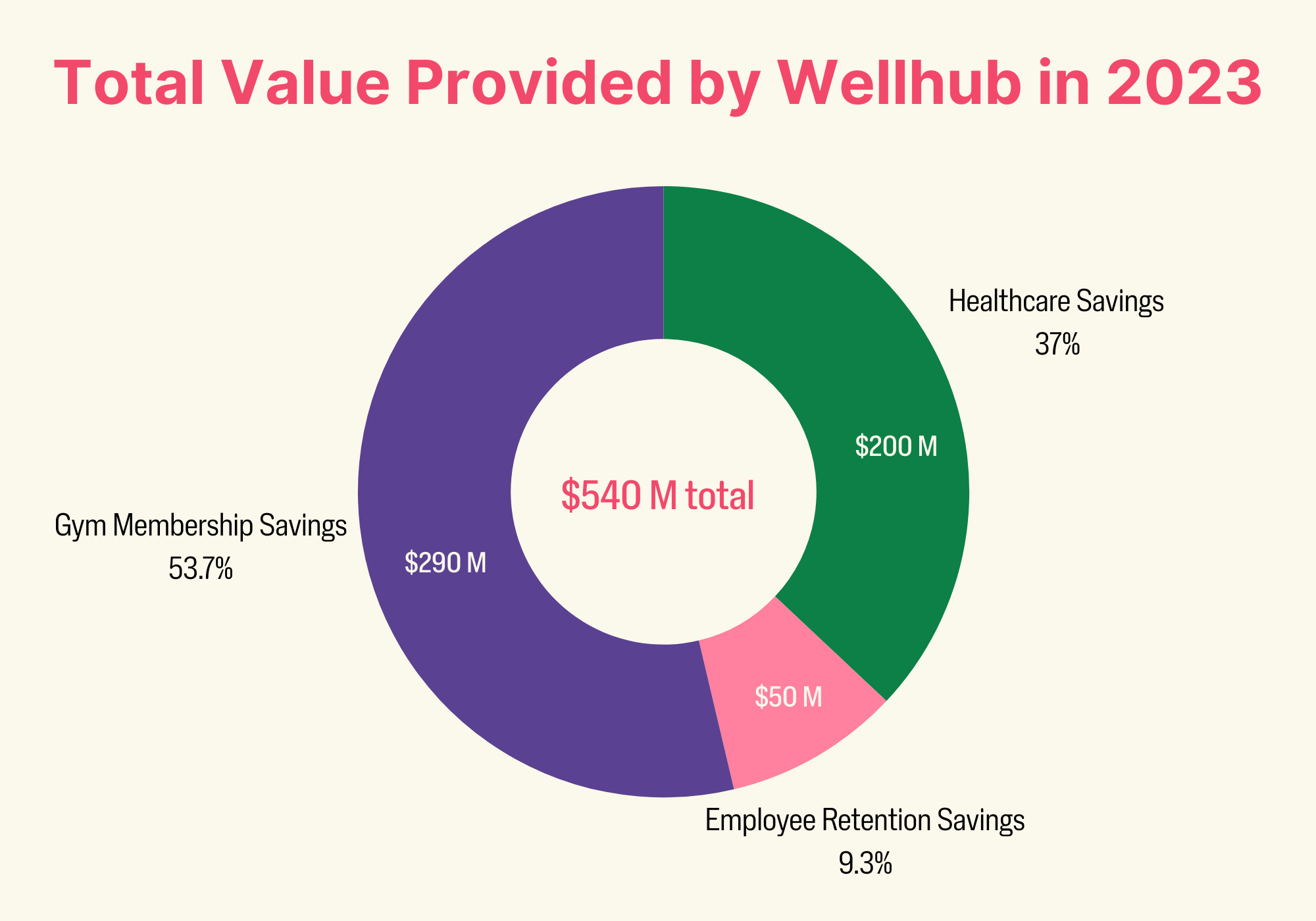
Healthier Outcomes Across Every Access Point
Unified programs give employees choices—and that choice drives better health.
- Employees who used Wellhub five or more times per month saw a 21% drop in healthcare costs over a year
- Employees who didn’t participate saw their healthcare costs increase by 14% over the same period
That’s a 35% swing—driven by accessible, flexible wellness options employees actually use.
This data comes from a longitudinal study of 50,000+ employees across industries, and it proves what HR leaders already know: when you give people multiple ways to engage, participation goes up—and costs go down.
Unified Programs Strengthen Retention
When wellness fits every lifestyle and schedule, people stay longer.
- In a year-long analysis, 88% of Wellhub clients saw reduced turnover among employees actively using the platform
- Those who checked in at least once a month were 30% less likely to leave their company
This is exactly where unified programs shine. By combining on-site, digital, and off-site options, you're not just meeting people where they are—you’re giving them one more reason to stay.
Meaningful Savings for Employees, Too
Unified wellness programs don’t just drive ROI for your organization—they put money back in your employees’ pockets, too.
In the U.S., employees using Wellhub save an average of $924 per year on gym memberships, fitness apps, and studio visits. That’s nearly 50% off what they’d pay out-of-pocket.
For HR leaders looking to boost perceived value without adding to base compensation, this is a highly effective lever. It’s a benefit employees actually use—and one they talk about.
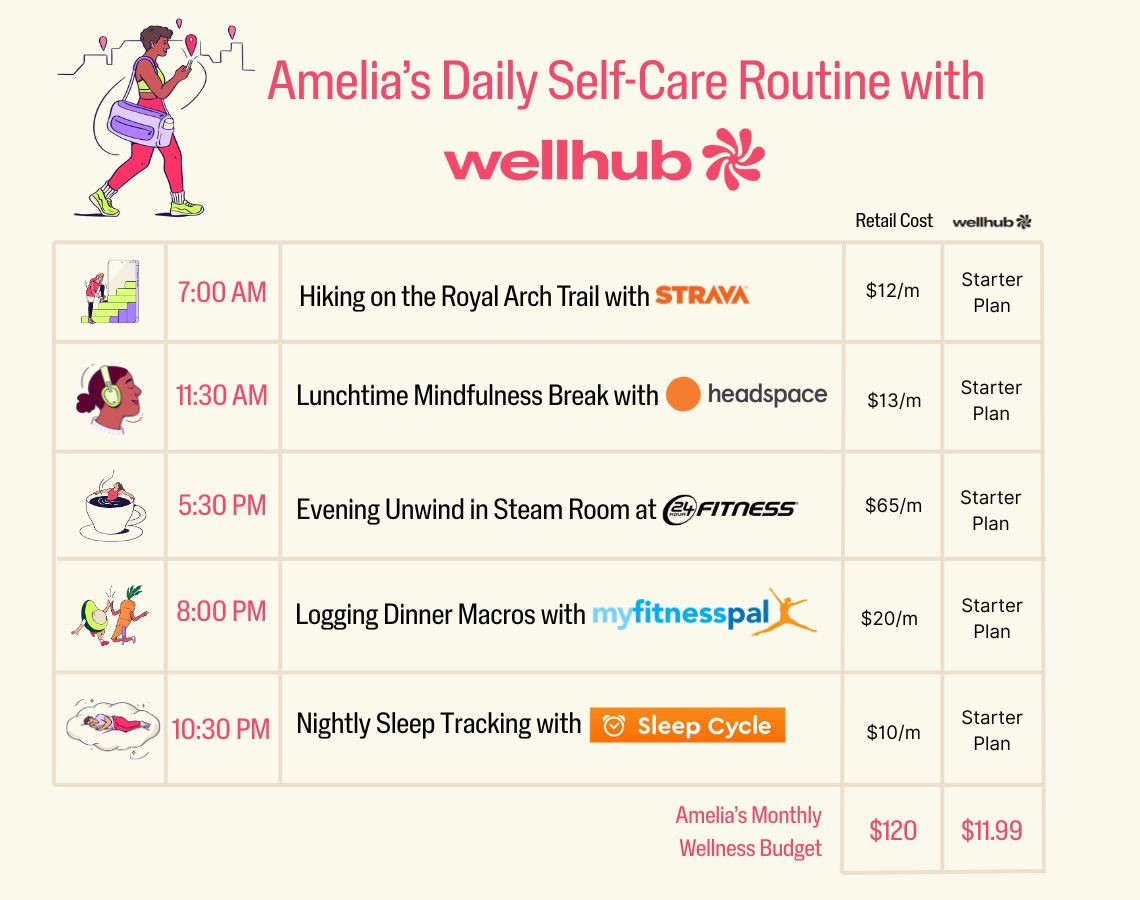
Usage Drives Impact
When employees use Wellhub more often, feel better andview your company more highly:
- 93% of daily users rate their benefits package positively (compared to 64% of monthly users)
- 71% of daily users report strong mental wellness (vs. 53% of non-users)
- 55% of daily users report better sleep (vs. just 26% of non-users)
The takeaway? When wellness is accessible through multiple touchpoints, employees engage more deeply—and your benefits program delivers more impact.
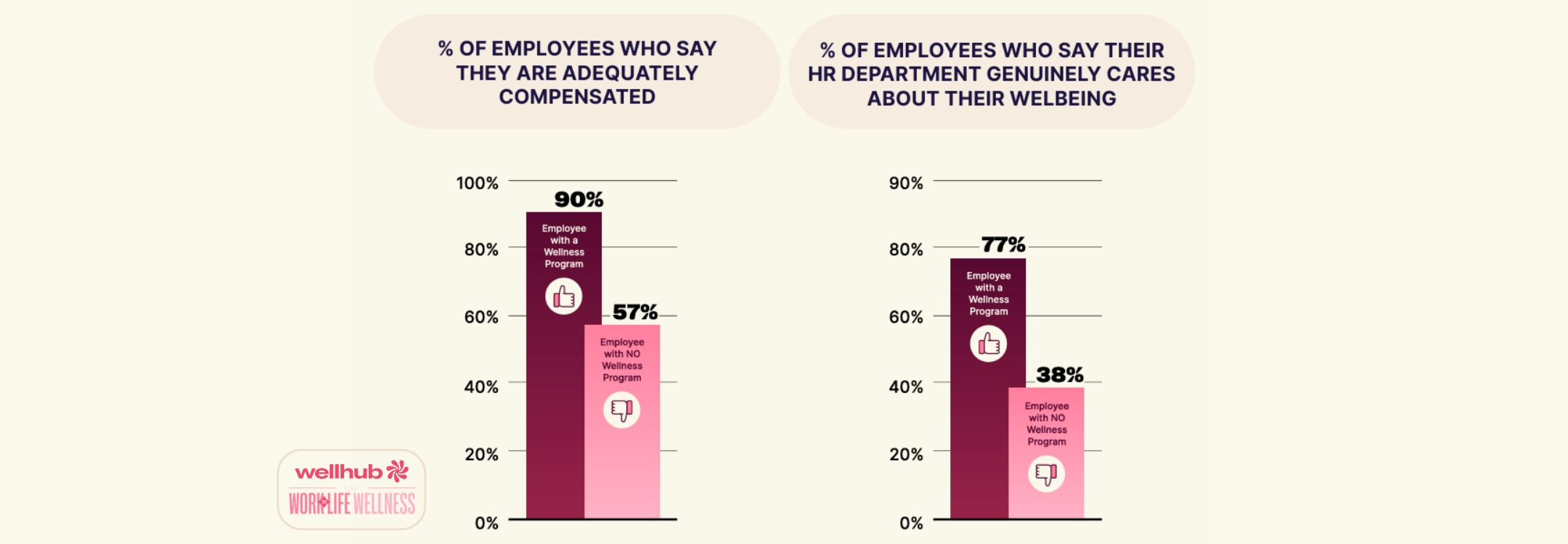
How HR Can Get the Most from a Unified (Digital and In-Person) Fitness Program
When implemented thoughtfully, a unified fitness plan can help HR leaders reduce healthcare costs, boost retention, and strengthen the overall employee experience. But unlocking that impact requires more than just offering options. It takes planning, communication, and the right partner.
Here’s how to get the most from your investment:
- Choose a Platform That Centralizes Everything
Managing multiple vendors, logins, or contracts creates friction—for both your HR team and your employees. A unified platform like Wellhub brings everything together: on-site classes, off-site gym access, and digital wellness tools, all in one place. That simplicity drives adoption and makes performance easy to track.
- Prioritize Flexibility for All Employee Types
Look beyond headquarters. Your program should support every employee, whether they work remotely, travel often, or split time between locations. Offering both digital and in-person access ensures no one is left out—and supports the diverse ways people engage with wellness.
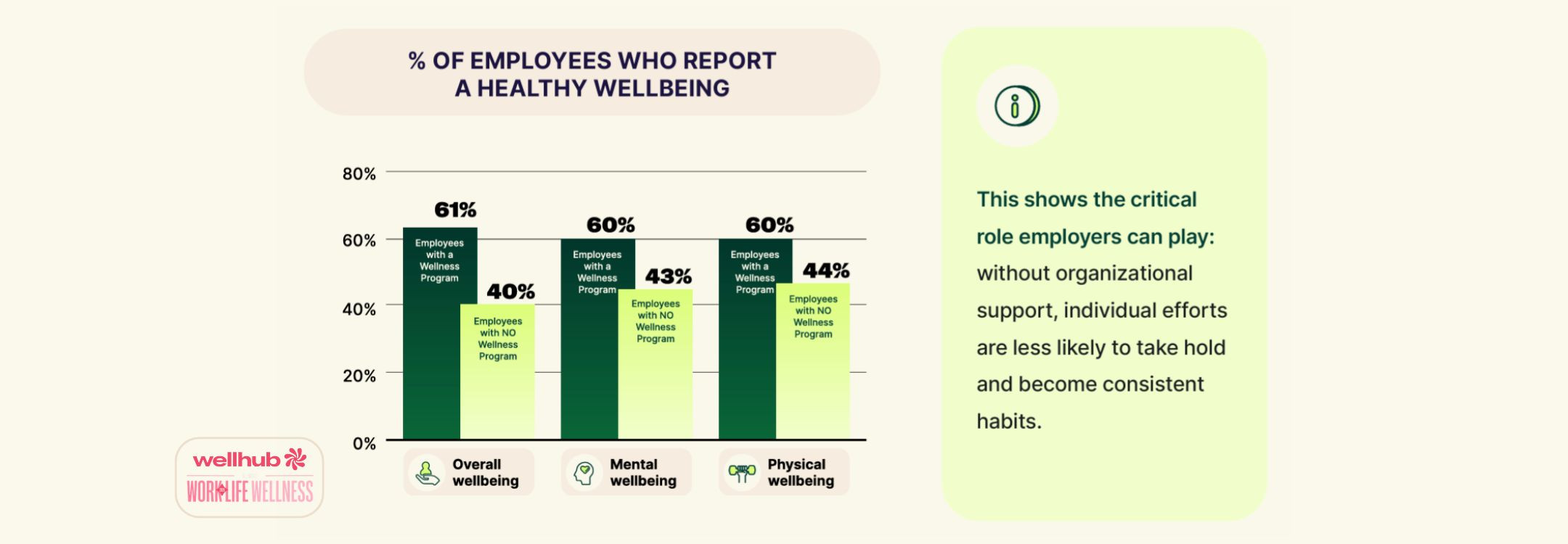
- Communicate Early and Often
Awareness is everything. Make sure your people know what’s available, how to access it, and what’s in it for them. Use onboarding, email campaigns, internal champions, and company events to keep the program top of mind year-round.
- Use Data to Guide Your Strategy
Wellness is most impactful when it’s tied to outcomes. With Wellhub, HR teams can access real-time data on usage, engagement, and ROI. These insights help you report on progress, optimize offerings, and make a stronger case for continued investment.
- Connect It to Your Broader Benefits Strategy
A unified wellness program strengthens your total rewards package. Make sure it’s positioned that way—alongside mental health support, PTO, and healthcare coverage. This reinforces your company’s commitment to whole-person wellbeing and helps attract and retain top talent.
When you bring all your wellness options into one unified system, your employees don’t have to choose between flexibility and access. And your HR team doesn’t have to choose between impact and manageability. Wellhub makes it easy to do both.
Legal, Safety, and Compliance for Corporate Fitness Programs
Employee wellness programs can bring a lot of value, but they also carry responsibilities, especially those involving physical activity like fitness programs. It's important to think about risk, accessibility, and privacy to protect your employees and your organization. A few things to have on your mind when working with your company's legal team include:
Liability and Waiver Considerations
Make it a requirement for employees to sign clear waivers for on-site exercise, and make sure trainers hold proper certifications. These documents confirm that employees understand the risks of physical training. Without them, a minor injury could snowball into a liability issue for the company, leading to reputational loss and a cut to the bottom line.
ADA and Accessibility Compliance
Corporate fitness facilities and digital platforms must be inclusive of people with disabilities, according to the Americans with Disabilities Act (ADA).
Specifically, facilities must be accessible to and usable by people with disabilities. The ADA recreation facility guidelines cover multiple facilities, including golf courses, miniature golf courses, bowling lanes, exercise equipment, swimming pools, spas, and wading pools.
Digital programs should also meet accessibility standards by providing screen-reader compatibility and closed captioning.
Health Data Privacy and HIPAA Concerns
Digital fitness platforms often collect sensitive health information, such as activity data or medical history. To stay compliant with the Health Insurance Portability and Accountability Act (HIPAA) and other privacy laws, establish strict policies for data collection, storage, and sharing. Regular audits and clear employee communication can also build trust and protect against fines and legal action.
Unified Fitness Meets the Needs of Today’s Workforce
Offering only in-person or digital fitness programs can leave big gaps in access and engagement—especially in a workforce that’s remote, hybrid, and always on the move. HR leaders face the challenge of supporting every employee, no matter their location or lifestyle.
Unified fitness programs solve that challenge. By blending in-person and digital options into one seamless experience, they boost engagement, reduce healthcare costs, and improve retention. In fact, employees who use Wellhub five or more times a month see a 21% drop in healthcare costs, while companies see 3x ROI on average.
Speak with a Wellhub Wellbeing Specialist to build a fitness program that works for everyone—without adding complexity to your plate.

Company healthcare costs drop by up to 35% with Wellhub*
See how we can help you reduce your healthcare spending.
Category
Share

The Wellhub Editorial Team empowers HR leaders to support worker wellbeing. Our original research, trend analyses, and helpful how-tos provide the tools they need to improve workforce wellness in today's fast-shifting professional landscape.
Subscribe
Our weekly newsletter is your source of education and inspiration to help you create a corporate wellness program that actually matters.
Subscribe
Our weekly newsletter is your source of education and inspiration to help you create a corporate wellness program that actually matters.
You May Also Like

Corporate Wellness Trends HR Must Know for 2026 | Wellhub
See the top 2026 wellness trends shaping performance, retention, and culture—plus how HR can build a unified, ROI-driven wellbeing strategy.

Wellness Points Programs: Boost Employee Health & Engagement | Wellhub
Turn your workplace wellness strategy around with a points program that rewards healthy behavior with perks, from extra time off to gift cards.

Employee Financial Wellness Programs: Ultimate HR Guide | Wellhub
Create an effective financial wellness program that supports your employees in their financial needs, boosting productivity and retention.